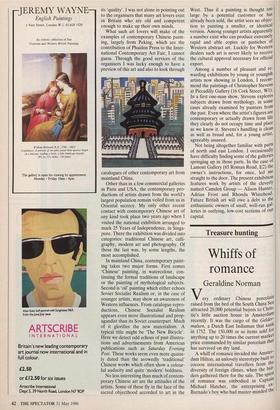Exhibitions
Christopher Stevens (Piccadilly Gallery till 21 June)
Camden Artists Group (Lamont Gallery till 7 June)
A very cool excuse
Giles Auty
By the time this issue appears, I hope to be ambling about the streets of Albi or Cordes and that the weather will be sunny. In common with most inhabitants of this country I would welcome at least a second morning of sunshine before the days start drawing in again in roughly three weeks' time. Clearly something is gravely wrong with our weather but the full facts are being deliberately concealed from us by weather men acting on official orders. `Today temperatures will rise to roughly the seasonal average' — this sounds reas- suring but actually means slightly above freezing — 'and tonight ground frosts will again be widespread.' Has nobody told them it's almost June?
The purpose of this preamble is not simply to give voice to a quite disturbing suspicion but to apologise to the organisers of the Art Fairs at Bath and Olympia, once again, for my absence. Both fairs promise a wealth of interest. The Bath Fair finished on 26 May, but all within easy travelling distance are urged to attend Olympia where the word 'International' — as in International Art Fair— just this once, has a broader meaning. In Britain, the interna- tional contemporary art placed before us in exhibitions and collections is often limited, give or take a piece or two, to that from just four nations: USA, West Germany, Italy and, of course, ourselves. Meanwhile, the contemporary art of four of the larger centres of world population is seldom, if ever, on view: Brazil, China, India and USSR. Nor do British contemporary ex- hibitions and collections exactly tumefy with the art of the Turk or bulge with that of the Bulgar. In short, the contemporary art of a great many nations is never set before us in Britain for our own public to judge, favourably or otherwise. The art We see is, to some extent, pre-censored and pre-judged for us by our appointed cultural masters. During last year's massive exhibi- tion of, 20th-century German art at the Royal Academy all art from the Nazi era was excluded on the ostensible grounds of its 'quality'. I was not alone in pointing out to the organisers that many art lovers exist in Britain who are old and competent enough to make up their own minds.
What such art lovers will make of the examples of contemporary Chinese paint- ing, largely from Peking, which are the contribution of Phaidon Press to the Inter- national Contemporary Art Fair, I cannot guess. Through the good services of the organisers I was lucky enough to have a preview of this art and also to look through catalogues of other contemporary art from mainland China.
Other than in a few commercial galleries in Paris and USA, the contemporary pro- ductions of artists drawn from the world's largest population remain veiled from us in Oriental secrecy. My only other recent contact with contemporary Chinese art of any kind took place two years ago when I visited the national exhibition arranged to mark 25 Years of Independence, in Singa- pore. There the exhibition was divided into categories: traditional Chinese art, calli- graphy, modern art and photography. Of these the last was, by some lengths, the most accomplished.
In mainland China, contemporary paint- ing takes two major forms. First comes `Chinese' painting, in watercolour, con- tinuing the formal traditions of landscape or the painting of mythological subjects. Second is 'oil' painting which either echoes Soviet Socialist Realism or, in the case of younger artists, may show an awareness of Western influences. From catalogue repro- ductions, Chinese Socialist Realism appears even more illustrational and prop- agandist than its Soviet counterpart. Much of it glorifies the new materialism. A typical title might be 'The New Bicycle'. Here we detect odd echoes of past illustra- tions and advertisements from American publications such as Saturday Evening Post. These works seem even more quaint- ly dated than the avowedly 'traditional' Chinese works which often show a colour- ful audacity and quite 'modern' boldness.
No less interesting than much of contem- porary Chinese art are the attitudes of the artists. Some of these fly in the face of the sacred objecthood accorded to art in the West. Thus if a painting is thought too large by a potential customer or has already been sold, the artist sees no objec- tion to painting a smaller, or identical version. Among younger artists apparently a number exist who can produce extremely rapid and able copies or pastiches of Western abstract art. Luckily for Western dealers such art is never likely to receive the cultural approval necessary for official export.
Among a number of pleasant and re- warding exhibitions by young or youngish artists now showing in London, I recom- mend the paintings of Christopher Stevens at Piccadilly Gallery (16 Cork Street, Wl)• In a first one-man show, Stevens explores subjects drawn from mythology, in some cases already examined by painters from the past. Even where the artist's figures are contemporary or actually drawn from life they clearly do not occupy time and place as we know it. Stevens's handling is clean as well as broad and, for a young artist, agreeably assured. Not being altogether familiar with parts of north and east London. I occasionally have difficulty finding some of the galleries springing up in those parts. In the case of Lamont Gallery (65 Roman Road, E2) the owner's instructions, for once, led me straight to the door. The present exhibition features work by artists of the cleverly named Camden Group — Alison Hunter, Adrian Frost and Rhonda Whitehead. Future British art will owe a debt to the enthusiastic owners of small, well-run gal- leries in outlying, low-cost sections of 010 capital.



























































 Previous page
Previous page